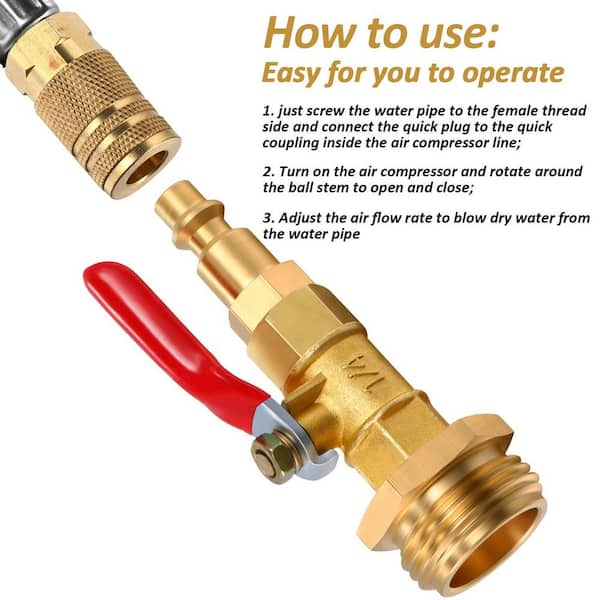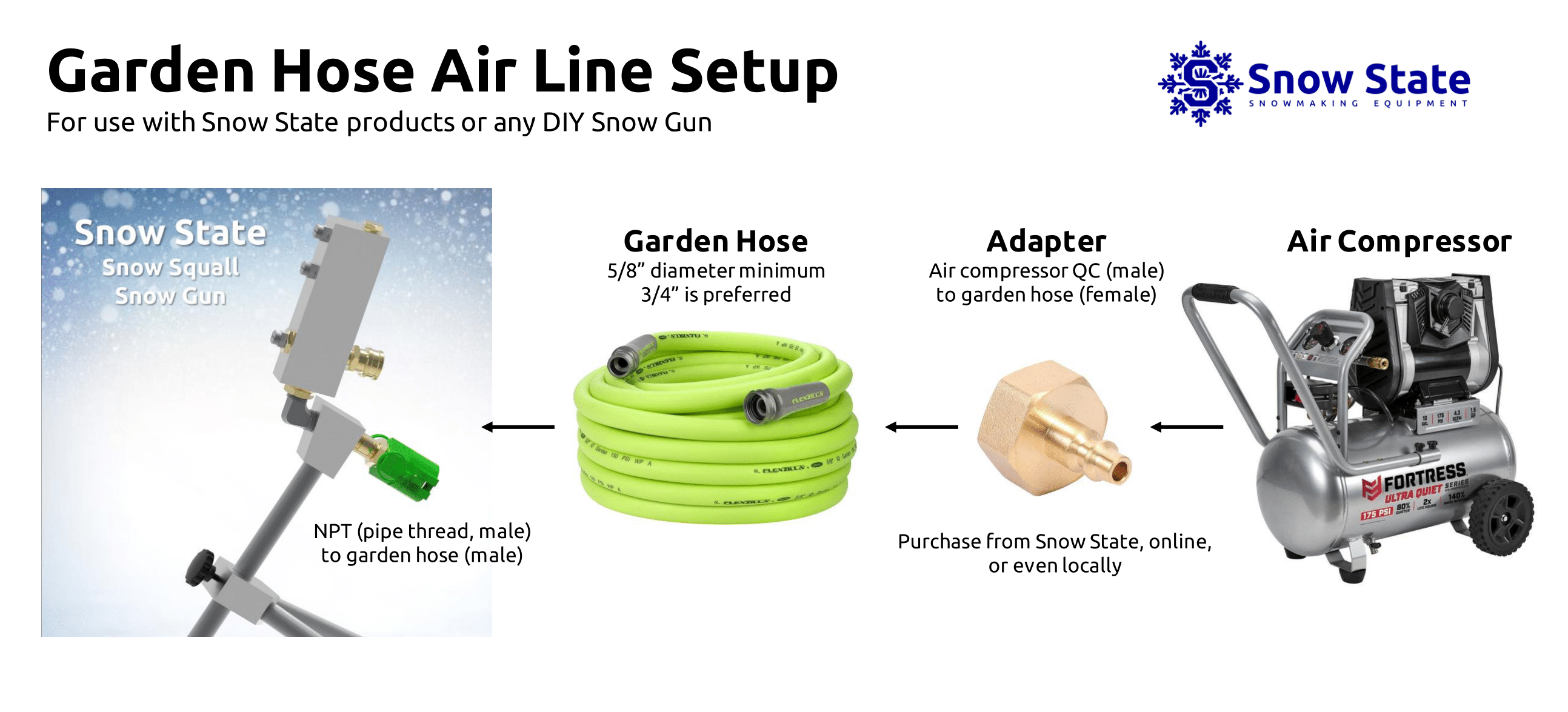Are you tired of struggling to connect your hose to your air compressor? Finding the right adapter can make all the difference in how smoothly your tools work.
Whether you’re a DIY enthusiast or a professional, having the perfect hose to air compressor adapter saves you time and frustration. You’ll discover exactly what to look for, how to choose the best adapter for your needs, and tips to ensure a secure, leak-free connection every time.
Keep reading to make your air compressor setup easier and more efficient than ever before.
Choosing The Right Adapter
Choosing the right hose to air compressor adapter is important for safe and efficient work. The adapter must fit well and work with your tools. A poor choice can cause leaks or damage. Focus on size, material, and thread type to find the best match.
Matching Hose And Compressor Sizes
Adapters come in different sizes. Match the hose size with the compressor’s outlet size. Measure the inner diameter of the hose and the compressor fitting. A tight fit stops air leaks and keeps pressure steady. Avoid forcing adapters that do not fit.
Material Types And Durability
Adapters are made from brass, steel, or plastic. Brass resists rust and lasts long. Steel is strong but may rust over time. Plastic is light and cheap but less durable. Choose material based on your work environment and frequency of use.
Thread Types And Compatibility
Threads connect the adapter to hose and compressor. Common threads include NPT, BSP, and quick-connect types. Check the thread type on both the hose and compressor. Using compatible threads ensures a secure, leak-free connection. Mismatched threads can cause damage.
Measuring For A Perfect Fit
Choosing the right hose to air compressor adapter starts with careful measurement. A perfect fit ensures air flows smoothly and safely. Measuring helps avoid leaks and connection problems. It saves time and money by preventing wrong purchases.
Measuring Hose Diameter
First, measure the hose diameter accurately. Use a ruler or caliper to find the outside diameter. Measure in millimeters or inches, depending on your tool. Check the hose end, where it connects to the adapter. Note the size to find a matching adapter.
Checking Compressor Port Size
Next, measure the air compressor port size. This is where the adapter attaches to the compressor. Use a ruler or caliper for precise measurement. Measure the outside diameter of the port. Write down the size to match with the adapter. This ensures a tight and secure fit.
Common Adapter Types
Hose to air compressor adapters come in several types. Each type serves a specific purpose. Choosing the right adapter helps connect hoses and tools easily. Understanding common adapter types makes your work smoother and faster.
Quick Connect Adapters
Quick connect adapters allow fast hose and tool changes. They use a push-and-click system for easy attachment. No tools are needed to connect or disconnect. These adapters save time and reduce hassle during projects.
Threaded Adapters
Threaded adapters screw onto hose ends or tools securely. They provide a strong, leak-free connection. These adapters fit different thread sizes and types. They work well for heavy-duty or high-pressure tasks.
Universal Adapters
Universal adapters fit many hose and tool types. They adapt different sizes and thread styles. These adapters offer flexibility for various equipment. Perfect for users with mixed tools and hoses.

Credit: www.amazon.com
Installation Tips
Installing a hose to air compressor adapter correctly is important for safe and efficient use. Follow these tips to ensure a solid connection. Proper installation helps avoid leaks and ensures smooth air flow. Take your time with each step to get the best results.
Preparing Hose Ends
Cut the hose ends clean and straight. Remove any dirt or debris. Use a sharp knife or hose cutter for a smooth edge. This helps the adapter fit tightly and prevents air leaks.
Securing The Adapter
Push the adapter firmly into the hose end. Tighten any clamps or fittings securely. Use a wrench if needed but avoid over-tightening. A snug fit keeps the adapter from slipping off during use.
Leak Testing
Turn on the air compressor and check for leaks around the adapter. Listen for hissing sounds or spray soapy water on the connection. Bubbles mean air is escaping. Tighten fittings more if you find leaks.
Maintaining Your Adapter
Maintaining your hose to air compressor adapter is essential for its long life and steady performance. Regular care helps avoid leaks and damage. Small steps keep your adapter working well and safe.
Regular Inspection
Check your adapter often for cracks or wear. Look for loose fittings and damaged threads. Catching problems early stops bigger issues later. Use a flashlight to see hard spots clearly.
Cleaning And Lubrication
Keep your adapter clean from dust and dirt. Wipe it with a soft cloth after use. Apply a small amount of lubricant to the moving parts. This reduces friction and prevents rust. Avoid using too much oil; just a thin layer works best.
Replacement Signs
Replace the adapter if you see cracks or leaks. Worn threads that won’t hold tight also need replacement. If air pressure drops during use, the adapter might be faulty. Don’t wait for failure—swap it out to stay safe.

Credit: www.homedepot.com
Troubleshooting Fit Issues
Fit issues with hose to air compressor adapters are common. These problems reduce air pressure and slow your work. Fixing them quickly saves time and improves safety.
Here are simple ways to identify and solve common fit problems.
Identifying Leaks
Leaks cause air loss and make compressors less effective. Listen for hissing sounds near connections. Use soapy water on joints and watch for bubbles. Bubbles mean air is escaping. Check all fittings carefully. Even a small leak affects performance.
Fixing Loose Connections
Loose connections cause leaks and reduce air flow. Tighten fittings by hand first. Use a wrench to secure connections firmly. Avoid over-tightening, which can damage threads. Ensure adapters match the hose and compressor size. Proper fit prevents loosening during use.
Dealing With Cross-threading
Cross-threading happens when threads do not align properly. This damages both the adapter and compressor. Start threading slowly and straight. Never force the connection. If threads feel stuck, back off and try again. Replace damaged adapters to avoid air leaks and safety risks.

Credit: snow-state.com
Frequently Asked Questions
What Is A Hose To Air Compressor Adapter?
A hose to air compressor adapter connects hoses to compressors securely. It ensures airtight seals for efficient air flow. This adapter fits various hose sizes and compressor fittings, enhancing tool compatibility. It’s essential for pneumatic tool operation and maintenance.
How Do I Choose The Right Adapter Size?
Check your hose diameter and compressor fitting size first. Match these dimensions with the adapter specifications. Using the correct size prevents air leaks and tool damage. Always verify manufacturer guidelines for compatibility before purchasing an adapter.
Can I Use Any Hose With An Air Compressor Adapter?
No, hoses must be compatible with the adapter type and size. Using incompatible hoses causes leaks and reduces performance. Select hoses rated for your compressor’s pressure and adapter design for safety and efficiency.
Are Hose To Air Compressor Adapters Durable?
Yes, quality adapters are made from durable materials like brass or stainless steel. These materials resist corrosion and wear. Durable adapters ensure long-term, reliable compressor connections and improved tool performance.
Conclusion
Choosing the right hose to air compressor adapter saves time and effort. It ensures a secure and tight connection every time. This small part helps your tools work better and last longer. Avoid leaks and pressure drops with a good adapter.
Keep your equipment safe and efficient by picking quality adapters. Simple, affordable, and useful—these adapters make your work easier. Don’t overlook this important accessory for your air compressor setup.

